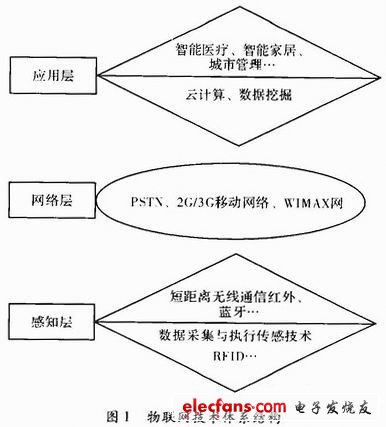The Internet of Things is the information industry technology following the computer, the Internet and the mobile communication network. With the widespread application of the Internet of Things technology and the importance of medical public health for people's livelihood, the integration of the Internet of Things technology and hospitals has become closer.
1 IoT basics
1.1 Internet of Things
The Internet of Things (Internet of Things) refers to the use of information sensing equipment such as radio frequency identification (RFID), infrared sensors, global positioning systems, laser scanners, etc., according to the agreed protocol, to connect any item to the Internet to complete intelligence A network of functions such as identification, positioning, tracking, monitoring, and management.
The architecture of the Internet of Things technology is shown in Figure 1. The perception layer is located at the lower level of three levels, and belongs to the object network, including intelligent embedded devices, audio, video data, etc. It is mainly used to collect physical events and data in the physical world. It can be said that the perception layer is to let objects "speak" Prerequisites. It is divided into two parts: data acquisition and execution, and short-range wireless communication. Data collection and execution is the use of intelligent sensor technology, RFID and other information collection technology to collect basic information on items, and at the same time receive control information sent by the upper network to complete the corresponding execution actions. Short-range wireless communication can complete the information concentration and intercommunication function of multiple items within a small range.

The network layer is located in the middle layer of three levels and belongs to the ubiquitous access network. It mainly uses the existing wide area network communication system, such as PSTN, 2G / 3G mobile network, WIMAX network, etc., to quickly, reliably and safely transmit information to various places To enable items to communicate over a large distance.
The application layer is located on the upper layer of the three layers and belongs to the Internet. It is used for information storage and computing decisions of the Internet of Things. It is equivalent to the control layer and decision layer of the Internet of Things. Realize the recognition and perception between things and between people and things, and play an intelligent role. The application of the Internet of Things involves smart transportation, smart medical care, smart home, smart logistics, smart power, etc. to complete the final interaction between items and people.
1.2 RFID
RFID (Radio Frequency IdenTIficaTIon), that is, radio frequency identification, commonly known as electronic tag, is a technology that uses radio frequency signals to automatically identify target objects and obtain relevant information, and is the most widely used technology in the Internet of Things. RFID uses wireless radio frequency to carry out non-contact two-way transmission of data between the reader and the radio frequency card to achieve the purpose of target identification and data exchange.
The basic RFID consists of 3 parts: tag, reader, antenna.
The tag, also known as a transponder, consists of a coupling element and a chip. The tag contains a built-in antenna and is used to communicate with the RF antenna.
Reader, also known as reader, is a device that performs read / write operations on RFID tags. It mainly includes two parts: radio frequency module and digital signal processing unit.
The antenna transmits radio frequency signals between the tag and the reader. It is a device that realizes the spatial propagation of radio frequency signals and establishes a wireless communication connection between the RFID tag and the reader.
Electrical Polyester Nonwoven Fabric
Electrical Polyester Nonwoven Fabric,Polyester Nonwoven Fabric,Polyester Spunbond Nonwoven Fabric,Spunbond Polyester Fabric
Longkou Libo Insulating Material Co.,Ltd. , https://www.liboinsulation.com
